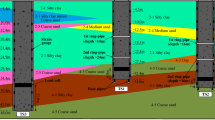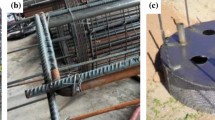Abstract
This paper presents bi-directional O-cell loading tests on two super-long and large-diameter drilled shafts with diameter of 2 m and lengths of more than 110 m. The field test results show that the ultimate bearing capacity of the shaft after post-grouting at the shaft tip and side is 1.95 times that of the shaft without post-grouting, and the total side resistance and the base resistance of the shaft after grouting at the shaft tip and side are 183% and 280–314% larger than that of the shaft without post-grouting, respectively. Consequently, the combined tip-and-side grouting has a significantly effect to improve the bearing characteristics of super-long and large-diameter drilled shaft. As the load reaches the maximum test load, the proportion of the load carried by the shaft base is not more than 20% before and after combined grouting. Furthermore, the relationship between side resistance and shaft-soil relative displacement for super-long and large-diameter drilled shaft is described by the hyperbolic model, and this model is also used to capture the base resistance-base displacement relationship. In addition, the base displacement required to fully mobilize the base resistance for the shaft after combined grouting is about 1.0% of shaft diameter.
Access provided by CONRICYT-eBooks. Download conference paper PDF
Similar content being viewed by others
Keywords
- Super-long and large-diameter drilled shaft
- Post-grouting
- Osterberg cell method
- Base resistance
- Side resistance
1 Introduction
With the continuous development of high-rise buildings and large bridges, the diameter and length of drilled shafts are increasing constantly, whereas super-long and large-diameter drilled shaft with a length of more than 50 m and a diameter of more than 2.0 m are also becoming more common. However, the problems of super-long and large-diameter drilled shafts are mainly manifested in the difficulty of construction, and quality is difficult to be guaranteed. For the above-mentioned issues, post-grouting technique has been gradually applied to the construction of super-long drilled shafts, especially in important projects [1, 2]. At present, post-grouting technique has become an effective method to enhance the bearing capacity of shaft and ensure the quality of shaft foundation [3, 4]. However, owing to the complexity of the mechanism for post-grouting technique, there is a need to analyze the response of grouted drilled shaft with super-long and large-diameter.
Based on two in-situ loading tests of Shishou Yangtze River Highway Bridge engineering, the behaviors and performance of combined tip-and-side grouting drilled shaft with super-long and large-diameter are studied by comparing the field test results of combined grouting shaft and shaft without grouting. The behaviors of side and base resistance under axial load are further investigated on the basis of the obtained data of strain gauges.
2 Project Description and Soil Conditions
Shishou Yangtze River Highway Bridge crosses the Yangtze River, which is located in Shishou, Central China. The proposed bridge will adopt long-span (which has a length of 820 m) of cable stayed bridge. The length of the main bridge is 1.45 km. According to the geological drilling at the bridge site, the results show that no bedrock is found within 180 m of the exploration. The soil layer at the site is composed of silty clay, fine sand and gravel. The design lengths of the main pylon shafts are up to 120 m. To investigate the behavior of super-long and large-diameter drilled shafts, it is necessary to test shafts in the proposed bridge site. The tested drilled shafts TS5 and TS6 were 2.0 m in diameter, had lengths of 110 m and 115 m, respectively.
3 Test Results
After the test shafts were formed, the shafts TS5 and TS6 were conducted to combined tip-and-side grouting. The detailed combined post-grouting sequences were discussed by [2]. The bi-directional O-cell test was applied in the test shafts, and double-level O-cell was mounted in the shafts for this test. The detailed about the double-level O-cell tests were described by [1]. In the following, based on the results of field test, we will study the behaviors and performance of super-long and large-diameter drilled shafts before and after post-grouting.
3.1 Load-Displacement Responses
The test results of the bi-directional O-cell before and after post-grouting were equivalently converted into the load-displacement curves of conventional static load test. Detailed equivalent conversion of the bi-directional O-cell test was described by [1]. Figure 1 presents the equivalent load-displacement responses of the shafts before and after combined grouting. It can be observed that the equivalent load-displacement curves of the shafts TS5 and TS6 before and after combined grouting have obvious inflections, and the equivalent displacement of the shafts increases gradually with increasing the equivalent load. [2] proposed that the load prior to failure can be regarded as the ultimate bearing capacity of a single shaft. Therefore, the ultimate bearing capacity of the shafts TS5 and TS6 before and after combined grouting are 52.22, 50.90, 101.44, and 99.12 MN, respectively. Consequently, the bearing capacity of combined grouting shaft is about 1.95 times than that of the shaft without grouting.
3.2 Mobilized Side and Base Resistance
Figure 2 shows the side resistance-relative displacement relationship and the base resistance-base displacement relationship for the shafts TS5 and TS6. It can be found that the side resistance-relative displacement relationship and the base resistance-base displacement relationship for the shafts are described by the hyperbolic model, as well as have a higher accuracy. It can also be observed from Fig. 2b that the base displacements required to fully develop the base resistance for the shafts before and after combined grouting are 11.39, 6.73, 20.01, and 22.24 mm, corresponding to 0.6%, 0.3%, 1.0%, and 1.1% of the shaft diameter, respectively. It is noted that the base displacement needed to mobilize base resistance for the shaft before grouting is smaller than that after grouting.
The ultimate bearing capacity, total shaft resistance, base resistance of each shaft, and their corresponding increased range are summarized in Table 1. The results in Table 1 show that the ultimate bearing capacity of the shafts after combined grouting in extra-thick fine sand layer is increased by about 95%, the total side resistance is increased by about 83%, and the base resistance is increased by 179.96–213.70%. At the ultimate load of the shafts TS5 and TS6, the ratios of the base resistance to the ultimate bearing capacity for the shafts before combined grouting are 8.67% and 13.97%, respectively, and increases to 11.47% and 16.53% after combined grouting, respectively. The test results show that the function of super-long and large-diameter drilled shaft after combined grouting still shows a friction shaft.
4 Conclusions
The paper presents the results of the bidirectional O-cell loading tests on two super-long and large-diameter drilled shafts before and after combined grouting. The test results demonstrate that the bearing capacity of combined grouting shaft is obviously larger than that of the shaft without grouting under the same conditions. At the ultimate load level, the total side resistance and base resistance for the shafts after combined grouting are increased by about 83% and 179.96–213.70%, respectively. Meanwhile, the proportion of the load carried by the shaft base after combined grouting is not more than 20%. The combined grouting drilled shaft with super-long and large-diameter is functioning as a friction shaft. Moreover, the relationship between side resistance and shaft-soil relative displacement for the shafts before and after combined grouting is described by the hyperbolic model, and the relationship between base resistance and base displacement for the shafts before and after combined grouting is also addressed in this model. Additionally, the base displacement needed to fully mobilize the base resistance for the shafts after combined grouting is about 1.0% of shaft diameter.
References
Dai, G., Gong, W., Zhao, X., et al.: Static testing of pile-base post-grouting piles of the Suramadu bridge. Geotech. Test. J. 34(1), 34–49 (2010)
Wan, Z., Dai, G., Gong, W.: Full-scale load testing of two large diameter drilled shafts in coral-reef limestone formations. Bull. Eng. Geol. Environ. 10, 1–17 (2017)
Bruce, D.A.: Enhancing the performance of large diameter piles by grouting. Ground Eng. 19(4), 9–15 (1986)
Mullins, G., Dapp, S., Frederick, E., et al.: Post grouting drilled shaft tips: Phase I. Research Report University of South Florida, Tampa, USA, pp. 127–156 (2001)
Acknowledgements
The authors would like to acknowledge financial support from the National Natural Science Foundation of China (51478109; 51678145) and China Postdoctoral Science Foundation (2017M611955).
Author information
Authors and Affiliations
Corresponding author
Editor information
Editors and Affiliations
Rights and permissions
Copyright information
© 2018 Springer Nature Switzerland AG
About this paper
Cite this paper
Wan, Z., Dai, G., Gong, W., Zhu, M. (2018). Field Study on the Behavior Super-Long and Large-Diameter Grouted Drilled Shafts. In: Wu, W., Yu, HS. (eds) Proceedings of China-Europe Conference on Geotechnical Engineering. Springer Series in Geomechanics and Geoengineering. Springer, Cham. https://doi.org/10.1007/978-3-319-97115-5_67
Download citation
DOI: https://doi.org/10.1007/978-3-319-97115-5_67
Published:
Publisher Name: Springer, Cham
Print ISBN: 978-3-319-97114-8
Online ISBN: 978-3-319-97115-5
eBook Packages: EngineeringEngineering (R0)






